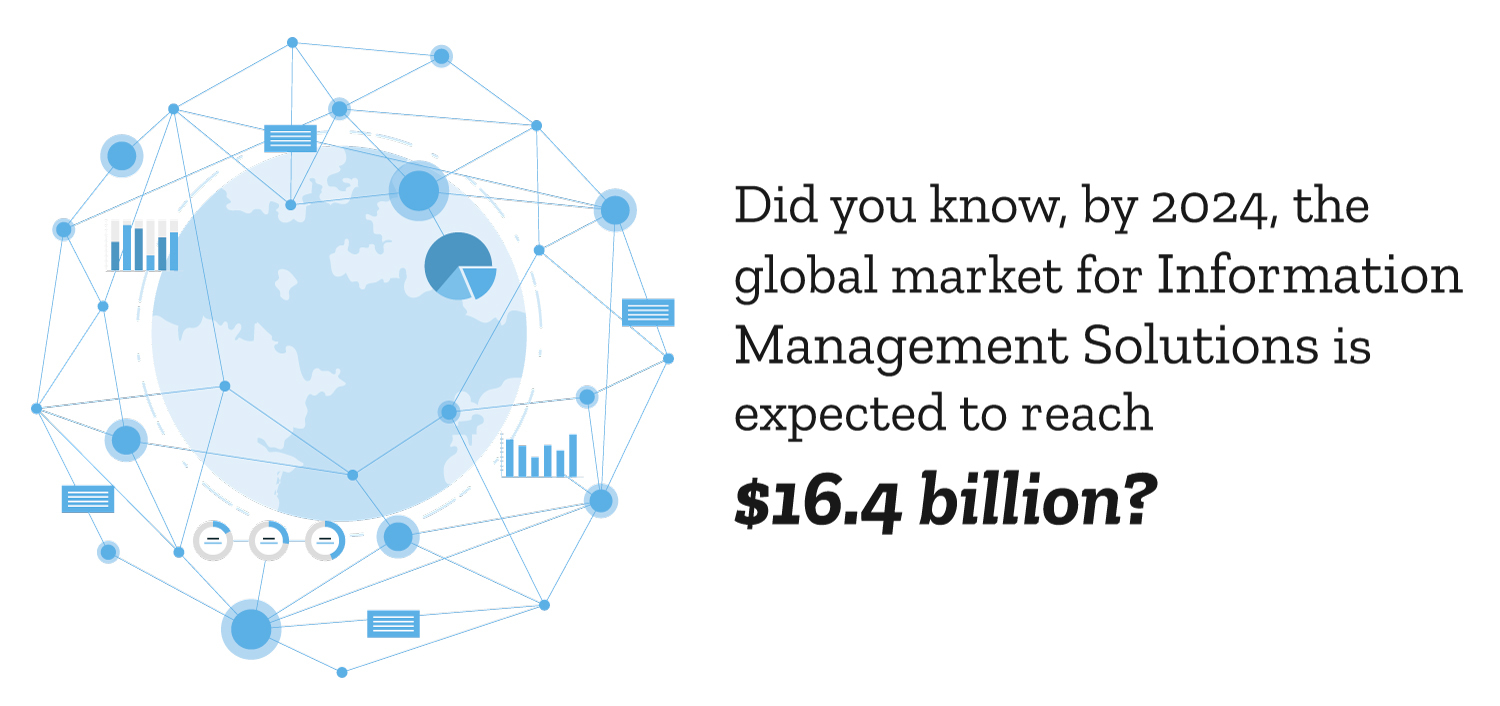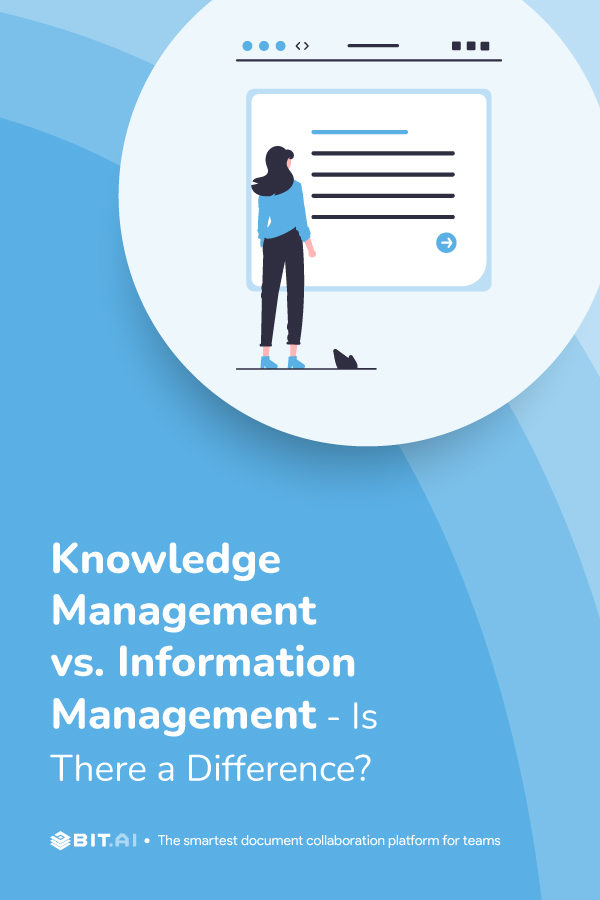Are you looking to enhance your organization’s performance and competitiveness? Do you want to leverage your employees’ collective knowledge and expertise to achieve these goals?
If so, you may consider implementing Knowledge Management and Information Management strategies.
Regarding managing organizational knowledge and information, two key approaches can be used: Knowledge Management and Information Management. While they share some similarities, these two approaches have different goals and strategies for achieving them.
Managing knowledge effectively can be the key to success in today’s fast-paced business environment, where data and information are abundant.
In this blog post, we’ll take a closer look at what Knowledge Management and Information Management are, how they differ, and why they are important for modern businesses.
Whether you’re a business owner, manager, or employee, understanding these concepts can help you make more informed decisions about managing information and knowledge within your organization.
So let’s dive in and explore the world of Knowledge Management and Information Management!
What is Knowledge Management?
Knowledge management is collecting, organizing, sharing, and utilizing information within an organization to improve its performance. It involves identifying the knowledge within an organization, capturing and storing it in a way that makes it easily accessible, and making it available to those who need it.
Okay, let’s break it down.
You know how your brain has a bunch of neurons that store information and help you make decisions? Well, think of knowledge management as the brain of an organization. It’s all about collecting and organizing an organization’s information to make better decisions and operate more efficiently.
It’s like having an organized and knowledgeable librarian in charge of all the information an organization needs. From best practices to project histories, knowledge management systems help ensure everyone in the organization has access to the information they need to get their job done.
And just like a librarian, knowledge management systems help filter out the noise and only give you what you need to know.
But why is knowledge management important?
Think about what would happen if your brain suddenly forgot everything you’ve ever learned. You’d have to re-learn EVERYTHING!
That’s kind of what happens when an organization doesn’t manage its knowledge well. It can’t build on past successes and must keep reinventing the wheel.
What’s more is, According to a study by McKinsey, organizations can potentially unlock $1.3 trillion in annual value by improving knowledge management!
So, in short, knowledge management is like a giant organizational brain that helps keep everything running smoothly. And just like your brain, it’s super important to take care of it so it can take care of you!
What is Information Management?
Think about all the data that we generate daily. From emails and text messages to social media posts and online transactions, a vast amount of information needs to be organized, stored, and accessed in a timely and accurate manner.
Information management involves collecting, storing, organizing, and using that information in an efficient, effective, and secure way. It involves managing physical and digital information, including documents, files, databases, and other forms of data.
Think of it like a big filing cabinet where you put all the important information needed to run a business or organization. You want to ensure that you can find what you need quickly and easily and that the information is accurate and up-to-date.
It helps businesses and organizations make better decisions. By having access to accurate and up-to-date information, they can make informed decisions based on real data rather than guesswork.

Of course, effective information management is not without its challenges.
With the massive volume of data generated daily, it can be difficult to keep up with all the information that needs to be organized and stored. Additionally, there are ever-present risks of data breaches and cyberattacks, which can lead to significant financial and reputational damage.
In summary, information management is a critical function that is essential for organizations to succeed in today’s digital world.
Alrighty, folks! Now that we’ve understood what knowledge and information management are, let’s dive into how they differ.
The Difference Between Knowledge Management & Information Management
Knowledge Management (KM) and Information Management (IM) are often used interchangeably but refer to different things.
Understanding the difference between knowledge and information management is important because they have different focuses, goals, and technologies. Knowing which to use in different situations can help organizations effectively manage their information and knowledge assets to improve their operations and achieve their goals.
 Information management primarily focuses on managing information as a resource. It involves collecting, storing, organizing, and disseminating information to make it available to those who need it. This information can take many forms, such as documents, data, and multimedia.
Information management primarily focuses on managing information as a resource. It involves collecting, storing, organizing, and disseminating information to make it available to those who need it. This information can take many forms, such as documents, data, and multimedia.
In contrast, knowledge management is focused on managing knowledge as a strategic asset. It involves identifying, capturing, storing, sharing, and applying knowledge and expertise within an organization to improve organizational performance and achieve strategic objectives.
While information management is concerned with managing information resources, knowledge management is concerned with managing intellectual assets, such as expertise, tacit knowledge, and best practices.
Imagine that you’re a chef, and you’re responsible for managing your kitchen. Information management would be like managing your pantry – you need to collect and organize all the ingredients you need to create your dishes, store them properly, and make sure they’re easily accessible when you need them.
This might involve keeping a detailed inventory of your ingredients, labeling them correctly, and creating a system for tracking their expiration dates. Now Let’s consider Knowledge Mangement.
Knowledge management would be like managing your recipes. Your recipes are a strategic asset that you use to create unique and delicious dishes. They represent the collective knowledge and expertise you’ve gained over years of cooking.
Managing your recipes involves identifying and capturing new ideas and techniques, organizing them in a way that’s easy to access, and sharing them with your team so that they can learn and improve their skills. By leveraging your knowledge and expertise, you can create new dishes and innovate in your cooking.
So, in summary, just like managing your pantry involves collecting and organizing ingredients, while managing your recipes involves leveraging your knowledge and expertise to create new and delicious dishes, information management focuses on managing information as a resource, while knowledge management is focused on managing knowledge as a strategic asset.
Another key difference between the two is the role of people.
Information management primarily focuses on managing information resources, while knowledge management recognizes the importance of people as knowledge creators, sharers, and users. Knowledge management recognizes that knowledge resides not only in documents and databases but also in employees’ minds.
Information management is about managing things, while knowledge management is about managing people.
Both are important for the success of an organization, and they work together to create a culture of learning, collaboration, and innovation.
Knowledge Management Vs Information Management: System
When managing information, information management tends to be all about technology. Think databases, content management systems, and search engines – all designed to store and retrieve huge amounts of data at the click of a button.
But knowledge management? That’s a whole other ball game.
 Knowledge management systems are more about creating a collaborative culture within an organization. Social networks, forums, and other platforms are used to spark conversations and encourage employee sharing of ideas, questions, and feedback. These systems may also help to capture and codify knowledge that is difficult to articulate or document.
Knowledge management systems are more about creating a collaborative culture within an organization. Social networks, forums, and other platforms are used to spark conversations and encourage employee sharing of ideas, questions, and feedback. These systems may also help to capture and codify knowledge that is difficult to articulate or document.
Both are important, but they have different focuses and approaches.
Knowledge Management Vs Information Management: Process
Knowledge Management (KM) and Information Management (IM) are related but distinct processes that involve the management of knowledge and information within an organization.
Knowledge Management involves the following processes:
- Knowledge creation: This involves generating new knowledge through research, experimentation, or innovation.
- Knowledge capture: This involves capturing knowledge from various sources, such as employees, customers, partners, and external sources.
- Knowledge storage: This involves storing knowledge in a way that is easily accessible and retrievable.
- Knowledge sharing: This involves sharing knowledge within the organization to facilitate collaboration and learning.
- Knowledge utilization: This involves using knowledge to improve decision-making, problem-solving, innovation, and overall organizational performance.
Information Management, on the other hand, involves the following processes:
- Information organization: This involves organizing information in a way that is meaningful and relevant to the organization.
- Information storage: This involves storing information in a secure and accessible manner.
- Information retrieval: This involves retrieving information as needed, quickly and efficiently.
- Information dissemination: This involves sharing information with others within the organization or externally, as appropriate.
- Information governance: This involves managing information to comply with relevant regulations, policies, and standards.
Both processes are critical for an organization’s success, and a well-designed KM and IM system can help an organization to leverage its knowledge and information assets for competitive advantage.
Knowledge Management Vs Information Management: Technology
Information Management (IM) and Knowledge Management (KM) are critical processes for managing information and knowledge within an organization. While technology plays a significant role in both processes, the nature of the information and knowledge being managed can affect the effectiveness of technology in supporting these processes.
Information Management benefits greatly from technology since the information being conveyed is already codified and easily transferrable. Technology can be used to manage information in a way that is efficient, secure, and easily accessible. This can include tools for organizing and categorizing information, database management systems, content management systems, and digital asset management tools.
On the other hand, Knowledge Management’s focus is on people and processes. While technology is extremely useful, it has a more complex role in transferring deeper, internalized knowledge. This kind of knowledge is passed from person to person through interaction, collaboration, mentoring, and preferably in an unstructured environment.
Therefore, IT tools for KM have to support this function, and they are not merely passing on information but also act as tools to bring people together, enhance communication, and allow the storage and transfer of unstructured thoughts and notes.
In other words, while technology can support KM processes by facilitating communication and collaboration, it cannot replace the human interaction and experience essential for sharing tacit knowledge. KM tools can include social media platforms, online collaboration tools, knowledge repositories, and expertise locators. These tools can facilitate the creation and sharing of knowledge, but they must be designed with the understanding that people and processes are the foundation of effective KM.
Related: Learn The Benefits of Knowledge-Sharing Between Software Teams!
Knowledge Management Vs Information Management: Is it easy to copy?
Knowledge Management (KM) and Information Management (IM) are crucial organizational processes. They facilitate the efficient and effective use of information and knowledge to drive decision-making, innovation, and growth. However, many organizations may wonder whether copying these systems from one organization to another is easy.
In this section, we will explore the factors contributing to the difficulty of copying KM or IM systems and the importance of tailoring these systems to an organization’s specific needs.
Is it easy to copy Knowledge Management or Information Management?
The short answer is no.
KM and IM systems are complex and multifaceted, and highly dependent on the unique context and culture of the organization. Simply replicating the same KM or IM system that worked well in one organization may not yield the same results in another organization.
This is because each organization has its own unique goals, values, resources, and constraints that affect how it manages its knowledge and information.
Factors that contribute to difficulty in copying either system
- Organizational culture: KM and IM systems are heavily influenced by organizational culture. The way employees perceive and use knowledge and information, as well as their attitudes towards sharing and collaboration, vary across organizations. This means the same KM or IM system may be more effective in one organization than another, depending on the culture.
- Information needs and resources: The types of information and knowledge that an organization needs to manage and the resources it has available to manage them can vary significantly. For example, a research organization may have different information needs and resources than a manufacturing company.
- IT infrastructure: The technology infrastructure that an organization has in place can significantly impact the effectiveness of its KM or IM system. This includes factors such as the availability of software, hardware, and networking resources and the level of IT support and expertise available.
- Leadership and management: The leadership and management practices within an organization can also significantly impact the success of its KM or IM system. This includes factors such as the level of support and commitment from senior management, the level of employee engagement, and the degree to which KM or IM is integrated into the overall organizational strategy.
Importance of tailoring Knowledge Management or Information Management to the specific needs of an organization
Given the above factors, it is clear that copying a KM or IM system from one organization to another is not a straightforward process. To be effective, these systems must be tailored to each organization’s specific needs and context.
By tailoring the KM or IM system to the organization’s specific needs, the system is more likely to be embraced by employees, integrated into the organizational culture, and effectively utilized to achieve the organization’s goals.
This, in turn, can lead to improved decision-making, innovation, and overall organizational performance.
Conclusion
In today’s fast-paced work environment, nobody has time for complicated knowledge sharing methods. That’s why it’s crucial to find a user-friendly solution that can help streamline this process.
One such tool is Bit.ai, a knowledge management software that simplifies the way employees collaborate, share, track, and manage all company knowledge in one place.

With Bit.ai, you can create and store any workplace documents such as company wikis, technical documents, training manuals, and client portal material. It’s a fantastic way to bring all your company information under one roof and manage projects, brainstorm ideas, and most importantly, share knowledge with your team in real time.
You can also create workspaces around projects, teams, departments, and clients to keep your documents, data, and knowledge organized. It’s easy to pin important items to the top, add new members to a workspace, and take your content organization to the next level with hierarchical folders.
Bit.ai is a fantastic knowledge management tool that simplifies the process of sharing knowledge in the workplace. So why not give it a try and see how it can transform the way your team works?
Further Reads:
Knowledge Sharing Platform vs Knowledge Base: The Key Differences!
Company Wiki vs Blog: What are the Differences & the Similarities?
Knowledge Sharing at the Workplace For Enhancing Productivity
Company Wiki: What it is & Why You Need it For Your Business?
Top Knowledge Management Examples for Business Productivity!
Knowledge Management Process: A Comprehensive Guide!
Top 10 Best Knowledge Management Tools in 2023!


